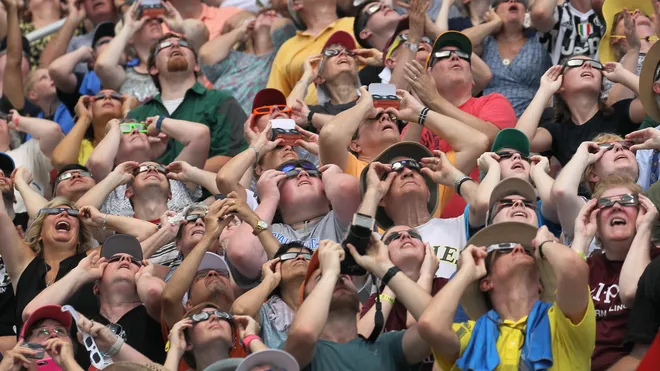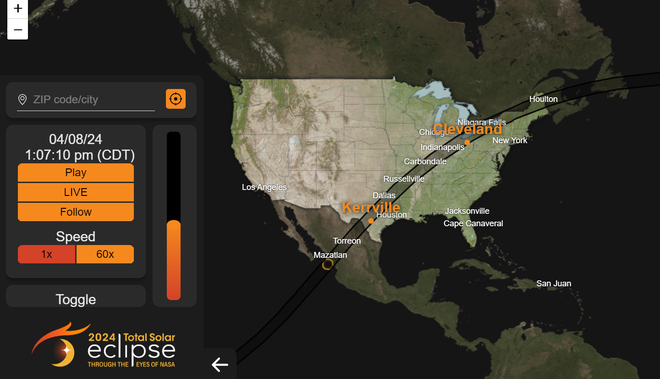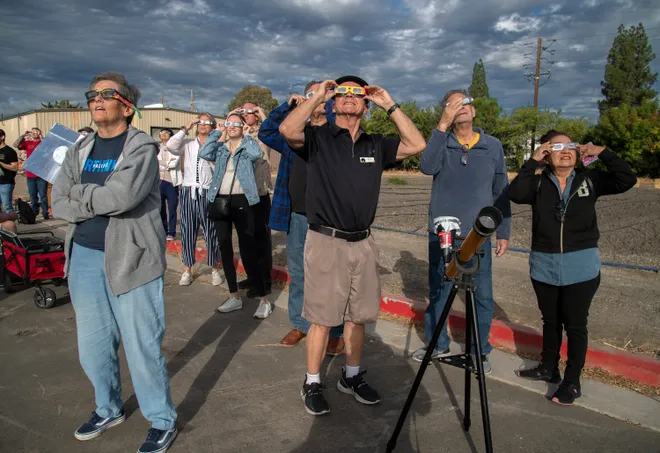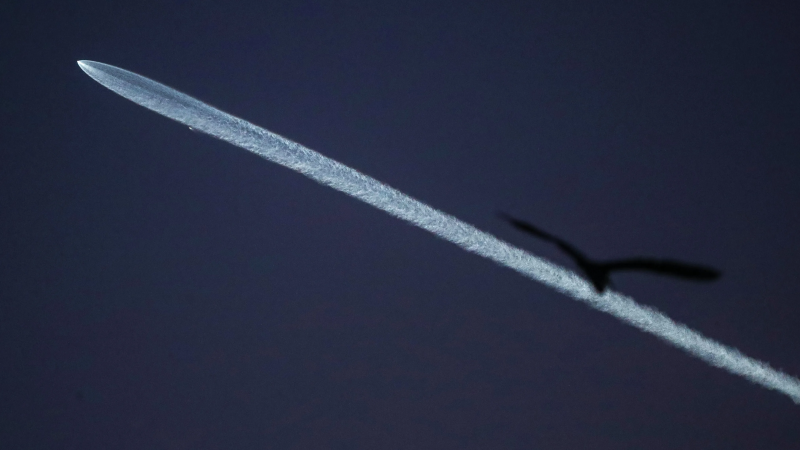The total solar eclipse is Monday: Here's everything to know, including time, path, safety
On Monday, a total solar eclipse will cross North America – a phenomenon that has not taken place in the United States in seven years, and astronomers say will not take place again in the U.S. for another two decades.
Millions will likely gaze into the sky on April 8 for the rare experience to witness three celestial spheres − the sun, moon and Earth − line up partially or fully depending on where you are viewing it.
What time will the total solar eclipse begin? What path will it take across the nation? How do I safely watch it without damaging my eyes?
Here's a list of important things you should know about Monday's potential once-in-a-lifetime event.

What is a solar eclipse?
Any celestial object like a moon or a planet that passes between two other bodies can create an eclipse by obscuring the view of objects like the sun.
A total eclipse occurs when the moon appears as the same size as the sun and blocks the entire disk from Earth, leading to a period of darkness lasting several minutes. The resulting "totality," whereby observers can see the outermost layer of the sun's atmosphere known as the corona, confuses animals – causing nocturnal creatures to stir and bird and insects to fall silent.
A recent study even found that clouds activity is altered by eclipses as shallow cumulus clouds were observed vanishing when the moon obscured the sun.
A driving no no during the eclipse:The one thing you'll want to do is the only thing not to do while driving during solar eclipse
What states are on the path of totality?
The total solar eclipse will chart a 115-mile-wide path of totality across portions of Mexico, the United States and Canada.
In the U.S. alone, hundreds of cities and smaller towns in 13 states lie along the path. An estimated 31 million Americans already live on the path, while millions more tourists are already making travel plans – sure to snarl traffic – to catch a glimpse of what is sure to be a spectacular sight, according to eclipse cartographer Michael Zeiler at GreatAmericanEclipse.com.
Additionally, small parts of Tennessee and Michigan are also expected to experience the eclipse, NASA says.
Here are the major cities in each state where you can expect to experience totality in the United States (note that the included times do not account for when the partial eclipse begins and ends):
- Dallas, Texas: 1:40-1:44 p.m. CDT
- Idabel, Oklahoma: 1:45-1:49 p.m. CDT
- Little Rock, Arkansas: 1:51-1:54 p.m. CDT
- Poplar Bluff, Missouri: 1:56-2:00 p.m. CDT
- Paducah, Kentucky: 2-2:02 p.m. CDT
- Carbondale, Illinois: 1:59-2:03 p.m. CDT
- Evansville, Indiana: 2:02-2:05 p.m. CDT
- Cleveland, Ohio: 3:13-3:17 p.m. EDT
- Erie, Pennsylvania: 3:16-3:20 p.m. EDT
- Buffalo, New York: 3:18-3:22 p.m. EDT
- Burlington, Vermont: 3:26-3:29 p.m. EDT
- Lancaster, New Hampshire: 3:27-3:30 p.m. EDT
- Caribou, Maine: 3:32-3:34 p.m. EDT

What time is the solar eclipse?
Mexico's Pacific coast will be the first location in continental North America to experience totality, which will occur at about 11:07 a.m. PDT, according to NASA.
As the moon's shadow travels northeast, totality in the U.S. will begin at 1:27 p.m. CDT in Eagle Pass, Texas. From there, the path will cut diagonally across the country before ending its time in the U.S. around 3:35 p.m. EDT in Lee, Maine, and entering Canada's maritime provinces, according to nationaleclipse.com.
Decoding the sky:A definitive solar eclipse guide for kids (adults also welcome)
How long will the total solar eclipse last?
Along the way, periods of darkness could last a mere few seconds or, in some cities, could surpass four minutes.
If you want to see the time and duration for when totality would occur near you, enter your zip code below to find out. You can also search for specifics on your location using this interactive map.
How to safely view the solar eclipse
Unlike partial solar eclipses, a total eclipse offers spectators a unique opportunity to gaze upon it with the naked eye, but only when the moon completely blocks out the sun and darkness falls – referred to as totality.
While you're unlikely to go blind, gazing directly at the sun's rays can do some serious damage to your retinas. So until the moment that totality occurs, proper safety eyewear is still a must, according to NASA.

While some welding goggles may work, the best option for eclipse viewing remains certified eyewear, which is held to an international safety standard and is 100,000 times darker than most sunglasses to block nearly all visible, infrared and ultraviolet light.
Solar eclipse glasses are readily available from plenty of vendors across the internet, but if you want to save some cash, there's a good chance your local library or another public institution is giving them away for free.
Just watch out for cheap imitations. To make it easy while you're shopping online, the American Astronomical Society maintains a curated list of approved vendors.
Another simple method is to create your own pinhole projector to project the sun onto a nearby surface. The American Astronomical Society offers helpful instructions to set them up as well.
When was the last solar eclipse?
The last solar eclipse took place on Aug. 21, 2017. In October, skygazers were delighted by a rare "ring of fire" solar eclipse, where the moon slides in front of the sun but doesn't totally obscure it, creating a halo effect.
When is the next total solar eclipse after 2024?
Whether you live on the path of totality or need to find the nearest city that will be enveloped in daytime darkness, one thing is for sure: Now is the time to make your plans to see it.
For North America, the next total solar eclipse won't be until Aug. 23, 2044, according to NASA.
Unfortunately, the 2044 total solar eclipse won't have the broad reach across the U.S. as the 2024 eclipse.

The Planetary Society, a nonprofit involved in research, public outreach and political space advocacy, says that during the 2044 eclipse, the path of totality will only touch three states.
The eclipse will begin in Greenland, sweep through Canada and end around sunset in Montana, North Dakota and South Dakota.
Contributing: Gabe Hauari
Natalie Neysa Alund is a senior reporter for USA TODAY. Reach her at nalund@usatoday.com and follow her on X @nataliealund. Eric Lagatta covers breaking and trending news for USA TODAY. Reach him at elagatta@gannett.com
Disclaimer: The copyright of this article belongs to the original author. Reposting this article is solely for the purpose of information dissemination and does not constitute any investment advice. If there is any infringement, please contact us immediately. We will make corrections or deletions as necessary. Thank you.



